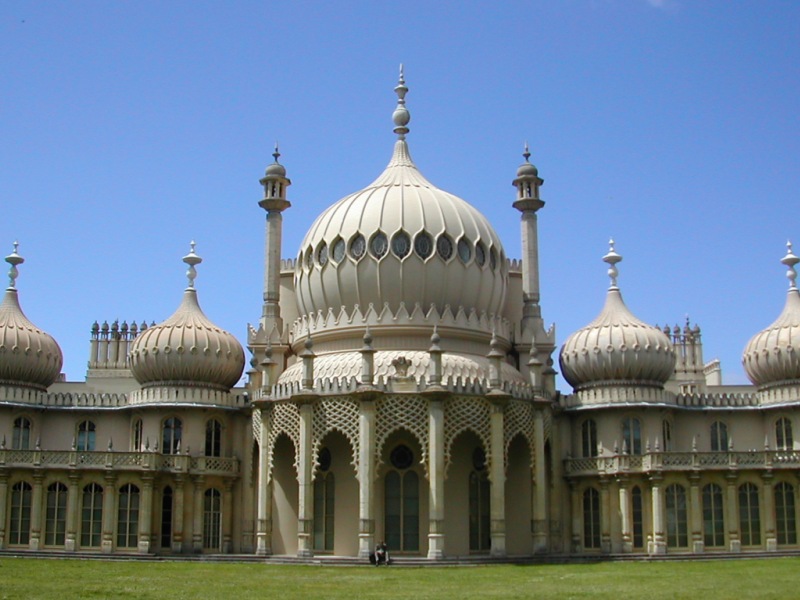Road Trip Through History: The Royal Pavilion at Brighton
Visiting the Royal Pavilion at Brighton was a sentimental journey for me.
As some of you may know, I did my PhD on the 20 year plan–in part because I kept wandering down odd and fascinating side roads that didn’t end up in the final dissertation.* Two of those academic dead ends were chinoiserie and Indian influence on English buildings. They collide magnificently in George IV’s little seaside cottage in Brighton.
The Pavilion started out as a farmhouse where George, then the Prince of Wales, happily canoodled with his long-term mistress, Mrs. Fitzherbert.** With the help of architect John Nash, the prince transformed his farmhouse over time into a royal fantasy: a Moghul palace on the outside,

Photo courtesy of Xjkkp via Wikapedia
“Chinese” interior decoration on the inside,
and a kitchen that made me want to pull on an apron and make a feast.
It was thrilling to see it all in real life after years of looking at plates.
Beyond the thrill of seeing the buildings, I was fascinated by two special exhibits: one about the use of the Pavilion as a hospital for Indian soldiers in World War I and the other an exhibit on George IV’s daughter, Princess Charlotte. The exhibit title calls Charlotte the forgotten princess–it’s a fair description. Even though I’ve spent a fair amount of time reading about Regency England, Charlotte had always been a little vague in my imagination. George IV’s only legitimate child, Charlotte was in some ways the alternate Victoria. Like her famous cousin, she was a short, plump, slightly Germanic princess with a stubborn streak. She refused to marry the man her father wished her to marry, the Prince of Orange (nicknamed “the Young Frog”), choosing instead the less eligible but handsome Prince Leo of Saxe-Coburg-Gotha***. Unlike her father and grandfather, the young princess was popular with the British people. Again like Victoria, she seems to have been happy with her German prince. When she died in childbirth in 1817 at the age of 21, the nation went into mourning.
As the only legitimate grandchild of George III, Charlotte’s death left the succession uncertain–and led her “wicked uncles” to hurry into matrimony. Victoria, daughter of the Duke of Kent and his brand-new wife, was born in 1819.
The exhibit left me hungry to know more about Princes Charlotte. Can anyone recommend a good book on the subject?
* This may not come as a surprise to those of you who have been reading along for a while now.
** George’s relationship with Mrs. Fitzherbert was complicated. In an act of have your cake and eat it too, they were married in what they both knew was an illegal ceremony years before he took the throne and were involved in a tumultuous on and off again relationship for the rest of his life. Their marriage did not stop George from later marrying his cousin Duchess Caroline of Brunswick, with whom he had a tumultuous, permanently off-again relationship for the rest of his life.
***Later the infamous King Leopold of Belgium, the butcher of the Congo.







Hi Pamela:
I’m quite jealous you’ve seen the Charlotte exhibit, as she will be the subject of a novel. Right now, she’s 2nd in line as I have another on the go.
I’ve been told the exhibit is quite small and there is no literature to speak of at the exhibit, which is quite disappointing as I had contacted the museum to request all the the literature they had. No response however.
I’ve been scouring used books stores and the Internet for research material. For non-fiction, I accummulated, inter alia,
Memoirs of Her Late Royal HIghness, Charlotte Augusta, Princess of Wales, Ect.: From Infancy to the Period of Her Much Lamented Death, Runeral Rites., Etc. (1818) ~ Robert Huish;
Caroline & Charlotte, The Regent’s Wife and Daughter, 1795-1821 ~ Alison Ploweden;
Letters of the Prince Charolotte 1811 – 1817 ~ Edited by A Aspinall;
A Brief Memoir of the Princes Charlotte of Wales ~ Rose Sophia M. Weigall, Charlottee Augusta;
Charlotte & Leopold ~ James Chambers;
A Sacred Memorial of Her Late Royal Highness Charlotte August, Princess of Wales, and of Saxe-Coburg Saalfeld (1818) ~ Robert Huish
The faithful mirror. Inscribed to her Royal Highness Princess August of Wales ~ Harriet. English
The “Daughter of Engand” was the hope of the nation after a king suffering from from dementia, followed by a degenerate son. Her life was short, but held so much promise.
Mourned with great outpouring of grief, Charlotte is largely forgotten by history as she did not live long to fulfill the hopes and dreams of the English people.
I continue with research on Charlottte, while writing my other novel. Hopefully, I will find more.
Darlene: I’m well acquainted with the research one project while you work on another juggling act.
Thanks for sharing this wonderful list. If I find anything else, I’ll pass it on.
Whaaaa?? How have I never realized that Charlotte’s handsome Leo and Leopold of the Congo were one and the same?! Or did I know this and forgot? Either way, shocking!
I listened to a good History Chicks podcast about Charlotte, but I don’t have any book recommends.
Here’s the podcast: http://thehistorychicks.com/?p=1477
It’s amazing the way historical bits link up, isn’t it?
Thanks for the podcast. Just what I need to make the stationary bike endurable!
An outstanding reportage, I am so glad I got to read it to augment my current knowledge on the subjects ie. Caroline, Charlotte, Leopold, Victoria,etc. Thanks